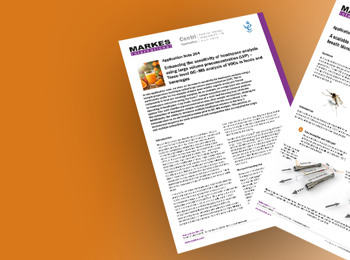
The POD Sampler and its role in passive air sampling – new data extends applications
Using the POD sampler for quantitative diffusive (passive) monitoring of volatile and very volatile organics in ambient air: Sampling rates and analytical performance
A new paper published in Environment International, presents a thorough validation of robust passive (diffusive) sampling rates for over 80 important VOC air pollutants, using the innovative POD sampler. Tested compounds include 50 ozone precursor and 42 air toxics.
In this post, we talk to Pascual Perez Ballesta, the inventor of the POD Passive Sampler, about the new sampling rates, associated validation data, and the importance of this work to ambient air monitoring.
 Pascual Pérez Ballesta (European Commission, Joint Research Centre) Pascual Pérez Ballesta (European Commission, Joint Research Centre)Pascual’s research at the European Reference Laboratory of Air Pollution has concentrated on the monitoring of organic pollutants. He has participated in numerous working groups for the development of European Air Quality legislation and contributed to the establishment of international standard methods. |
The POD Sampler has been deployed by users in a number of ambient air studies since 2016 – what feedback have you received so far?
As a POD user, I can honestly say that I have been impressed by its performance, both in terms of precision and robustness. Unlike other passive samplers, POD is not prone to sorbent loss and can be re-used almost indefinitely. It is also compact and easy to deploy both for personal and environmental monitoring.
Why did you feel this recent work was important and can you tell us a bit more about what was involved?
Currently, there is a growing regulatory demand and scientific interest for monitoring so-called ‘ozone precursors’ and other toxic organic compounds in ambient air. The simplicity and cost-effectiveness of diffusive sampling technique lends itself to polluted areas which are difficult to access using other techniques and allows quantitative data to be collected at more monitoring points thereby improving the quality of results.
The extended range of sampling rates determined during this study expands the monitoring capabilities of the POD sampler and its potential applications.
Can you tell us a bit more about the laboratory and field tests carried out to validate the new sampling rates?
The experiments allowed us to identify representative sampling rates for a relatively large number of ozone precursors and air toxics using two well-recognized adsorbents, Carbopack X and Cabograph 5TD – both of which are conveniently hydrophobic. The level of uncertainty associated with each sampling rate indicated the suitability (strength) of the analyte-adsorbent combination and how stable those rates were across a range of sampling times and conditions. The study also highlighted a few ‘air toxic’ and ‘ozone precursor’ compounds that weren’t suitable for passive monitoring using these sorbents, notably the most volatile species such as C2 hydrocarbons.
How quantitative is the POD? Were many parallel field studies carried out with alternative air sampling techniques and how closely did the results agree? Could you talk a bit more about these aspects?
Over recent years, we have published several papers demonstrating application of the POD sampler alongside other monitoring techniques such as canister sampling, pumped tube sampling, or online analysers. During this latest study POD samplers were deployed in parallel with pumped tube sampling and online analysers to monitor a range of ambient environments. As with other previous studies we found excellent correlation of concentration levels and very similar levels of uncertainty demonstrating the effectiveness of POD sampler as a quantitative monitoring tool for these 80+ important organic pollutants in ambient air.
Some of the sampling rates reported in the paper are quoted as stable over extended periods of time and wide concentration ranges. However, a few compounds, particularly the most volatile species, seem to require a rate that is specific to the duration of monitoring – Please can you explain the difference between them?
Diffusive sampling is similar to other sampling methods in that it has limits. For many air toxic and ozone precursor compounds, the strength of analyte – adsorbent interaction with Carbograph 5TD or Carbopack X respectively allows sampling rates to remain constant over a wide range of sampling periods and concentrations. However, analytes with weaker interactions may experience a reduction in the concentration gradient as the adsorbent becomes saturated. If/when this occurs, it can result in a progressive decrease in the sampling rate, which can be calculated from the specific analyte-adsorbent isotherm. When this happens, a given sampling rate is typically quoted for a specific range of sampling periods and concentrations.
Compounds behaving like this are highlighted in the new publication together with the means for calculating the appropriate sampling rate to be applied across multiple monitoring situations without the need for further tests. Information on the associated uncertainty is also provided.
How sensitive is the POD Sampler to other ambient variables such as wind velocity and temperature?
Environmental variables such as humidity, temperature and windspeed can indeed affect the performance of diffusive monitors, particularly early badge-forms, however, the design of diffusive barrier used in every POD sampler all but eliminates these issues by uniformly controlling and slowing the rate of analyte uptake across the exposed sorbent surface.
The selection of suitably-strong yet hydrophobic sorbents such as Carbograph 5TD and Carbopack X is also important in this regard.
Overall, varying the wind velocity was shown to have minimal impact on the sampling rate as expected. Furthermore, a temperature change of ±10°C during sampling was found to be associated with an increase of uncertainty between 2% and 15%, depending on the compound.
Why do you think this study is important to air pollution regulators and test labs around the world? When should they consider using passive sampling instead of pumped tubes, canisters or online air monitoring and what are the advantages of the POD in particular?
The study provides a greatly extended range of useful POD passive (diffusive) sampling rates for important target compounds in ambient air and demonstrates the quantitative equivalence of POD samplers to other standard reference methods such as pumped sorbent tubes, online analysers and canisters.
Compared to other techniques, the POD sampler was also found to provide similar levels of uncertainty and the same or better sensitivity because POD provides the means for integrating time-weighted average measurements over extended periods.
The main benefit of this new study is therefore that it will allow researchers and regulators to appreciate the inherent simplicity and low-cost advantages of passive (diffusive) sampling for a much wider range of air measurements across multiple application areas: ambient, indoor and workplace air plus human exposure studies.
Several prominent international standards already cover the option of passive (diffusive) sampling with solvent-free thermal desorption – GC(-MS) analytical methods. These include:
- ISO 16017-2
- ASTM D6196
- EN 14662-4
- US EPA Method 325
- prEN on ozone precursors (under development)
Special offer - 25% off a POD Sampler starter kitOffer applies automatically when buying online from the Markes shop or quote PODOFFER23 to claim your discount when buying via email or phone. |



![Markes TD Brochure Hero3 Corepurple[2]](/media/zmscvqds/markes-td-brochure-hero3-corepurple-2.jpg?cc=0.55128205128205132,0,0,0&width=350&height=260&v=1d660d04edbcca0)




